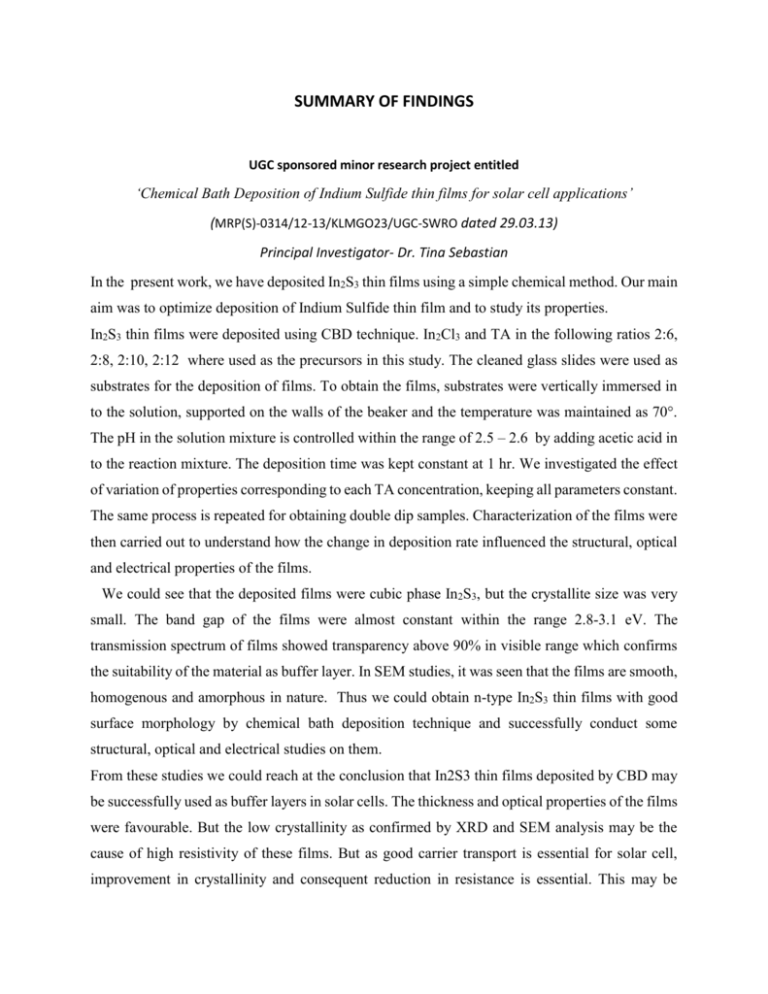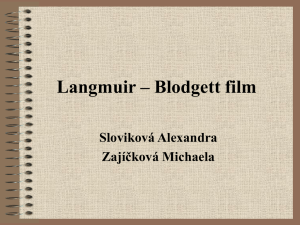View
advertisement

SUMMARY OF FINDINGS UGC sponsored minor research project entitled ‘Chemical Bath Deposition of Indium Sulfide thin films for solar cell applications’ (MRP(S)-0314/12-13/KLMGO23/UGC-SWRO dated 29.03.13) Principal Investigator- Dr. Tina Sebastian In the present work, we have deposited In2S3 thin films using a simple chemical method. Our main aim was to optimize deposition of Indium Sulfide thin film and to study its properties. In2S3 thin films were deposited using CBD technique. In2Cl3 and TA in the following ratios 2:6, 2:8, 2:10, 2:12 where used as the precursors in this study. The cleaned glass slides were used as substrates for the deposition of films. To obtain the films, substrates were vertically immersed in to the solution, supported on the walls of the beaker and the temperature was maintained as 70°. The pH in the solution mixture is controlled within the range of 2.5 – 2.6 by adding acetic acid in to the reaction mixture. The deposition time was kept constant at 1 hr. We investigated the effect of variation of properties corresponding to each TA concentration, keeping all parameters constant. The same process is repeated for obtaining double dip samples. Characterization of the films were then carried out to understand how the change in deposition rate influenced the structural, optical and electrical properties of the films. We could see that the deposited films were cubic phase In2S3, but the crystallite size was very small. The band gap of the films were almost constant within the range 2.8-3.1 eV. The transmission spectrum of films showed transparency above 90% in visible range which confirms the suitability of the material as buffer layer. In SEM studies, it was seen that the films are smooth, homogenous and amorphous in nature. Thus we could obtain n-type In2S3 thin films with good surface morphology by chemical bath deposition technique and successfully conduct some structural, optical and electrical studies on them. From these studies we could reach at the conclusion that In2S3 thin films deposited by CBD may be successfully used as buffer layers in solar cells. The thickness and optical properties of the films were favourable. But the low crystallinity as confirmed by XRD and SEM analysis may be the cause of high resistivity of these films. But as good carrier transport is essential for solar cell, improvement in crystallinity and consequent reduction in resistance is essential. This may be brought about by annealing the films at high temperatures. The films were annealed at 200, 300 and 400 degrees and characterized using X-ray diffraction, FTIR, SEM, EDAX, Absorption, Transmission studies etc. From the absorption studies it is seen that the sample annealed at higher temperature shows a wider band gap of 3.6eV.The band gap of three samples are obtained in the range of 3.08 to 3.61eV, which shows that In2S3 can be used as a substitute for CdS buffer layer in solar cells. The transmission spectrum of all the films showed transparency above 80% in visible range which confirms the suitability of material as buffer layer. The thickness of the films was found to be approximately 100nm using Gravimetric method. XRD analysis showed that the film exhibit a mixture of cubic and tetragonal phase and when we annealed the sample at higher temperature there is a transition from cubic to tetragonal structure. XRD analysis also shows that the crystallite size of the samples get decreased as we annealed the sample at higher temperature. SEM images revealed that there are agglomerations on the surface of all the samples and the non-uniformity reduces in samples annealed at 3000C. EDAX analysis showed that sample annealed at 2000C gave a better stoichiometric composition, closer to the expected ratio in near stoichiometric samples. This can be the reason for the lowering of band gap of this sample. From the FTIR analysis, it is observed that all the samples contain hydroxyl group and sample annealed at 3000C contains oxygen which can be the cause for widening of band gap in this sample. From the present study, we could reach at the conclusion that air annealing has great influence on the properties of In2S3 thin films prepared by CBD technique and can be effectively used to tune the structure, composition and properties of the deposited layers.






